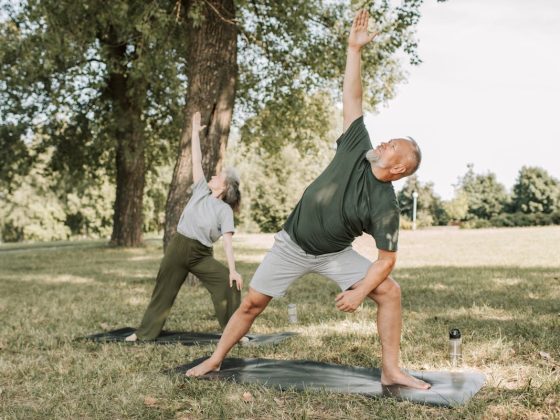In today’s fast-paced world, stamina is more important than ever. Whether you’re an athlete looking to improve your performance or an individual seeking to enhance your overall health and well-being, building endurance can lead to significant benefits. This article will explore various exercises that increase stamina, discuss their importance, and provide tips for incorporating them into your routine.

Understanding Stamina
Stamina is the ability to sustain prolonged physical or mental effort. In the context of exercise, it refers to the capacity to maintain physical activity for an extended period. This endurance is critical not only for athletes but also for anyone looking to improve their daily functional capacity.
The Importance of Stamina
- Improved Performance: Enhanced stamina allows athletes to perform at higher intensities for longer durations. For example, elite marathon runners can maintain a pace of 5 to 6 minutes per mile for 26.2 miles due to their superior endurance. Improved stamina is also beneficial for recreational athletes who want to increase their performance levels in sports like soccer, basketball, or cycling.
- Weight Management: Increased stamina facilitates more intense workouts, which can contribute to burning more calories and managing weight effectively. Studies show that individuals who incorporate high-intensity workouts can burn significantly more calories during and after exercise than those who do moderate-intensity workouts.
- Better Health: Regular endurance exercise promotes cardiovascular health by strengthening the heart, lowering blood pressure, and improving circulation. Research published in the Journal of the American College of Cardiology indicates that individuals who engage in regular aerobic exercise have a 30-40% lower risk of heart disease compared to sedentary individuals.
- Enhanced Mental Health: Physical activity releases endorphins, which can reduce stress and anxiety levels while boosting mood and cognitive function. According to the Anxiety and Depression Association of America, regular physical activity can reduce feelings of depression and anxiety, offering a natural alternative or complement to traditional treatments.
- Increased Energy Levels: As your stamina improves, you’ll likely find that you have more energy for daily activities, reducing feelings of fatigue. Studies have shown that individuals who engage in regular aerobic exercise report lower levels of fatigue and greater overall energy.
Types of Exercises That Increase Stamina
1. Aerobic Exercises
Aerobic exercises are the most effective for building stamina. They involve continuous and rhythmic activities that elevate the heart rate and promote oxygen consumption.
a. Running
Running is a classic aerobic exercise that can significantly boost your stamina. The American Heart Association recommends at least 150 minutes of moderate-intensity aerobic activity per week, and running is an excellent way to meet that goal. Start with shorter distances, gradually increasing your mileage as your endurance improves.
Training Plans: Consider following structured training plans such as the Couch to 5K program, which gradually builds running distance over several weeks. You can also incorporate tempo runs and long runs into your regimen to improve your endurance.
b. Cycling
Cycling is another excellent way to build stamina. Outdoor cycling provides varying terrain, which can enhance muscle engagement and cardiovascular fitness. The Journal of Sports Science & Medicine highlights that cycling improves aerobic capacity significantly in participants over a 12-week program.
Training Tips: Aim for longer rides at a moderate pace, gradually increasing your distance. Participating in group rides can also motivate you to push your limits. Incorporate hill climbs and intervals for a more challenging workout.
c. Swimming
Swimming provides a full-body workout while being easy on the joints, making it ideal for those with injuries. It’s an excellent way to build stamina, especially for individuals with joint issues. A study published in the International Journal of Sports Medicine found that participants who swam regularly showed significant improvements in cardiovascular fitness compared to those who did not.
Stamina-Building Techniques: Focus on different strokes (freestyle, breaststroke, backstroke) to engage various muscle groups. Swim sets that include intervals can also help improve your overall stamina, such as swimming at a fast pace for 50 meters, followed by a slow recovery lap.
d. Rowing
Rowing combines both aerobic and strength training, making it a comprehensive workout. It targets multiple muscle groups, including the back, legs, and arms. The British Journal of Sports Medicine indicates that rowing improves cardiovascular fitness and muscular endurance.
Rowing Techniques: You can use a rowing machine or participate in outdoor rowing. For optimal stamina-building, aim to row at a consistent pace for longer durations while gradually increasing resistance. Try rowing for 20-30 minutes at a moderate pace, incorporating short bursts of speed to simulate race conditions.
2. High-Intensity Interval Training (HIIT)
HIIT workouts alternate between short bursts of intense activity and brief periods of rest or lower-intensity exercise. This type of training has been shown to improve both aerobic and anaerobic endurance.
a. Structure of a HIIT Workout
A typical HIIT workout might include exercises such as burpees, sprinting, jumping jacks, and mountain climbers. For example, you might perform 30 seconds of high-intensity work followed by 15 seconds of rest, repeating this cycle for 20-30 minutes. Research indicates that HIIT can improve VO2 max—a measure of cardiovascular fitness—more effectively than moderate-intensity continuous training.
Sample HIIT Routine:
- Warm-up: 5 minutes of dynamic stretching
- Circuit (repeat 4 times):
- 30 seconds of burpees
- 30 seconds of rest
- 30 seconds of squat jumps
- 30 seconds of rest
- 30 seconds of high knees
- 30 seconds of rest
b. Benefits of HIIT
- Time Efficiency: HIIT workouts can be completed in a shorter amount of time than traditional cardio sessions while still delivering significant stamina improvements. A 20-minute HIIT session can yield similar or better results than an hour of steady-state cardio.
- Increased Metabolism: HIIT boosts your metabolism even after your workout is over, helping with weight management. This phenomenon, known as excess post-exercise oxygen consumption (EPOC), means your body continues to burn calories at an elevated rate after you finish exercising. Studies show that individuals can burn up to 15% more calories post-HIIT workout compared to traditional workouts.
3. Circuit Training
Circuit training combines strength training with aerobic exercise, making it an effective way to build stamina.
a. Designing a Circuit
Create a circuit that includes a mix of strength and cardio exercises. For example, you could alternate between push-ups, squats, jumping rope, and lunges. Aim for 10-15 repetitions of each exercise, moving quickly from one to the next.
Example Circuit:
- Jumping jacks (1 minute)
- Push-ups (15 reps)
- Bodyweight squats (20 reps)
- Mountain climbers (1 minute)
- Plank hold (30 seconds)
b. Benefits of Circuit Training
- Variety: The combination of different exercises keeps workouts interesting and can help prevent boredom. Studies show that varied workouts can increase adherence to exercise programs.
- Full-Body Engagement: Circuit training can enhance overall endurance by working multiple muscle groups simultaneously. This approach leads to comprehensive fitness improvements and can be tailored to focus on specific goals, such as strength endurance or cardiovascular fitness.
4. Sports and Recreational Activities
Participating in sports is a fun way to increase stamina. Engaging in activities like soccer, basketball, or tennis not only improves cardiovascular fitness but also promotes agility and coordination.
a. Team Sports
Joining a team sport can provide motivation and accountability. The competitive aspect often pushes individuals to improve their stamina while enjoying the camaraderie of teammates. Sports like soccer require continuous running and quick changes in direction, which significantly enhances endurance.
Example: Playing a game of soccer involves running an average of 7 miles during a match, which challenges both aerobic and anaerobic systems.
b. Individual Sports
If you prefer solo activities, consider sports like running, cycling, or martial arts. These allow for personal goal-setting and the ability to track your stamina improvements over time. For instance, setting personal bests in running distances or times can provide ongoing motivation.
5. Flexibility and Mobility Work
While not directly linked to stamina, flexibility and mobility exercises are crucial for overall fitness. They help prevent injuries and improve performance, allowing you to engage in stamina-building exercises more effectively.
a. Yoga
Yoga enhances flexibility, balance, and core strength. Many styles of yoga, such as Vinyasa or Power Yoga, incorporate elements of endurance training through continuous movement. Regular practice can improve your body awareness and help you maintain proper form during more intense workouts.
Benefits of Yoga: Research shows that individuals who practice yoga regularly report improvements in mental clarity, stress management, and recovery times from intense workouts.
b. Dynamic Stretching
Incorporate dynamic stretches into your warm-up routine to prepare your body for intense workouts. This can improve your range of motion and overall performance during stamina-building exercises. Examples include leg swings, arm circles, and walking lunges, which activate your muscles and joints and enhance blood flow.
Tips for Increasing Stamina
- Set Realistic Goals: Start with achievable goals, such as increasing your workout duration by a few minutes each week. Gradually build up your stamina without overwhelming yourself. Utilize SMART (Specific, Measurable, Achievable, Relevant, Time-bound) criteria to define your goals.
- Consistency is Key: To see improvements, commit to a regular exercise routine. Aim for at least 150 minutes of moderate aerobic activity or 75 minutes of vigorous activity each week, along with strength training twice a week. Consistency not only builds physical endurance but also helps to establish a long-term habit.
- Listen to Your Body: Pay attention to how your body responds to different workouts. If you experience pain or excessive fatigue, allow for rest and recovery. Recognizing signs of overtraining is crucial to avoid burnout and injuries. Common signs include persistent muscle soreness, decreased performance, and increased irritability.
- Stay Hydrated: Proper hydration is essential for optimal performance. Drink plenty of water before, during, and after your workouts to maintain energy levels. In longer sessions, consider electrolyte drinks to replenish lost minerals. The National Academies of Sciences, Engineering, and Medicine recommends an average daily water intake of about 3.7 liters (about 13 cups) for men and 2.7 liters (about 9 cups) for women.
- Incorporate Rest Days: Allow your body time to recover. Rest days are crucial for muscle repair and stamina building, so be sure to include them in your routine. Active recovery, such as light walking or yoga, can also be beneficial. Research suggests that incorporating rest days can enhance performance by allowing muscles to recover and adapt.
- Fuel Your Body: A balanced diet rich in carbohydrates, proteins, and healthy fats is essential for providing the energy needed for endurance training. Carbohydrates are particularly important for replenishing glycogen stores post-workout. According to the American College of Sports Medicine, athletes should consume 6-10 grams of carbohydrates per kilogram of body weight daily to maintain performance.
- Track Your Progress: Keep a workout journal or use fitness apps to track your progress. Monitoring improvements can help you stay motivated and make necessary adjustments to your training regimen. Recording details like distance, duration, and perceived exertion can give you insights into your stamina development.
- Incorporate Cross-Training: Mixing up your workouts with different forms of exercise can prevent boredom and reduce the risk of overuse injuries. Consider activities like hiking, dancing, or Pilates as alternative ways to boost your stamina while keeping things fresh.
Conclusion
Increasing stamina is essential for improving athletic performance and enhancing overall health and well-being. By incorporating a variety of exercises that increase stamina—such as aerobic workouts, HIIT, circuit training, and sports—individuals can achieve their fitness goals and enjoy a more active lifestyle. Remember to be patient and consistent in your efforts, and always listen to your body as you work towards building endurance.
With dedication and the right approach, you’ll be well on your way to greater stamina and improved fitness. Embrace the journey, celebrate your progress, and enjoy the benefits that come with improved endurance.
By focusing on a well-rounded approach to training that includes aerobic exercises, strength training, flexibility work, and proper nutrition, you can build the stamina necessary for any physical endeavor. Increased stamina not only enhances athletic performance but also enriches your everyday life, empowering you to tackle challenges with energy and enthusiasm.




